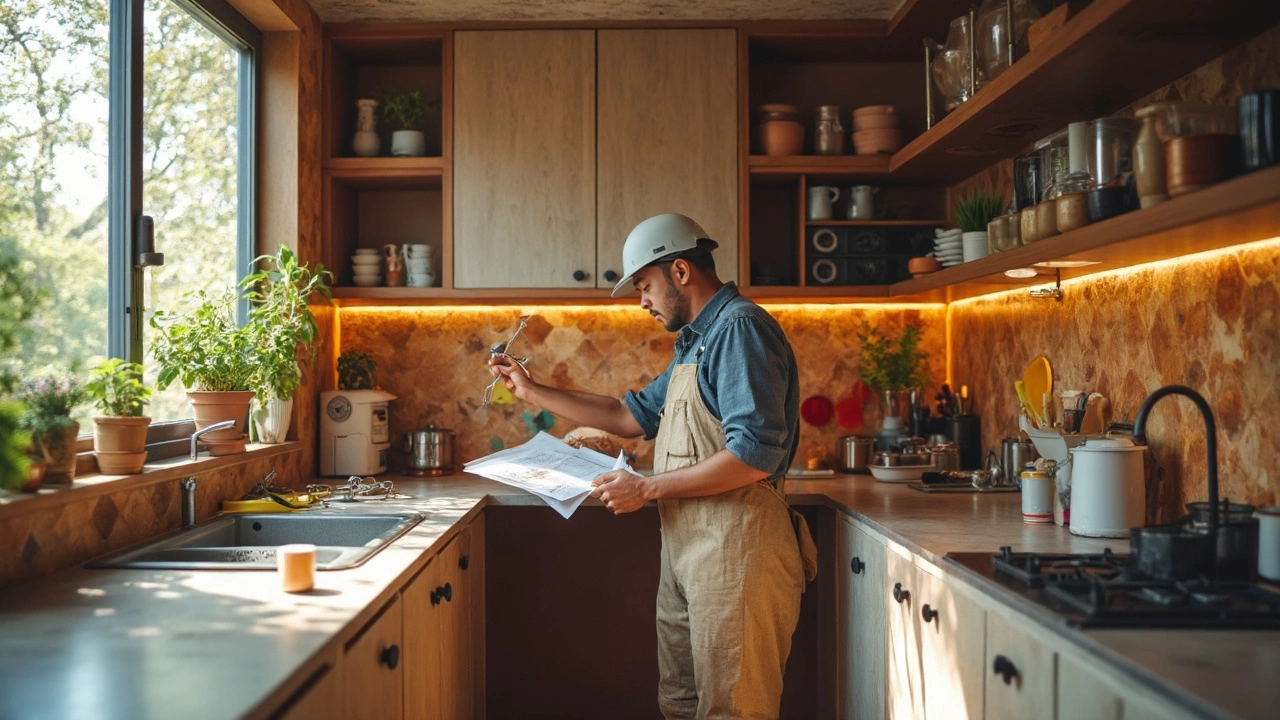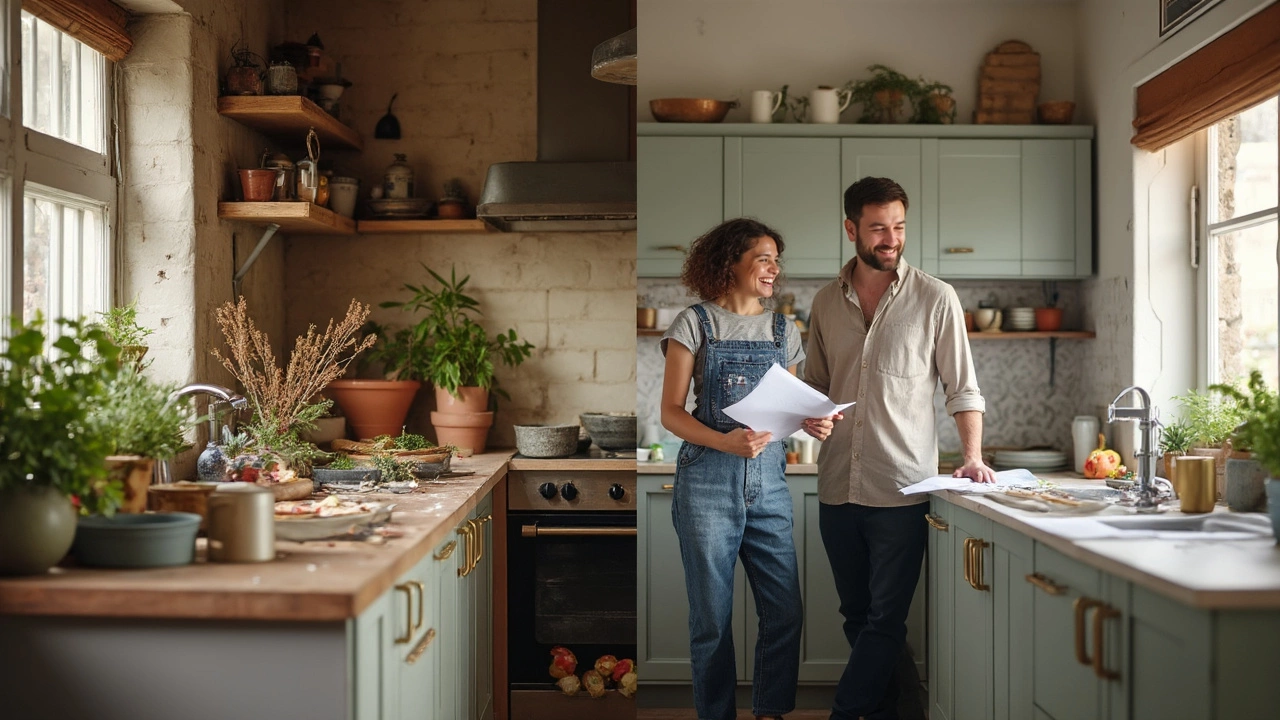How Much Would Someone Charge to Fit a Kitchen? Price Breakdown, Facts, and Tips

Sticker shock is common when people hear what it actually costs to get a kitchen fitted. You can walk into a showroom, see a price on display, and think you’re good. But the installation bill is often a whole different beast.
Kitchen fitting isn’t just screwing cabinets to the wall. Most jobs include tearing out the old kitchen, adjusting electrics and plumbing, handling tiling and flooring, and sorting out all those fiddly details nobody tells you about. That’s why you see quotes ranging from about £1,500 for basic installs, to £6,000 or more if you’re reworking pipes, wiring, or walls.
And here’s a fact that surprises a lot of people—fitters usually charge separately for plumbing, gas, and electrics. So even if your mate says he’s a ‘kitchen fitter’, double-check if he’s bringing in specialists for those jobs (if not, run a mile).
Instead of focusing on the cheapest price, look at what’s actually covered in the quote. Some fitters include small extras, like adjusting doors or fixing minor walls. Others treat every little task as an extra fee. If you don’t pin that down before you start, your bill can balloon fast. Nobody wants that kind of surprise halfway through a remodel.
- What Adds Up in Kitchen Fitting Costs?
- Labour, Materials, and Hidden Fees Explained
- Real-World Price Examples by Kitchen Size
- How to Save Money on Your Kitchen Install
- Questions to Ask Before Hiring a Kitchen Fitter
What Adds Up in Kitchen Fitting Costs?
There’s way more to the cost of a kitchen install than buying cabinets and paying a bloke to screw them in. Every extra job, hidden surprise, or last-minute tweak shows up in your final bill. Knowing what goes into the price helps you spot where you’re spending and where you can save.
You’ll usually see these main things adding up:
- Kitchen fitting costs: This is the bread and butter—the main job of getting units, doors, and worktops in place.
- Old kitchen removal: Ripping out what’s already there is messy work, and some fitters charge extra landfill or disposal fees.
- Electrics and lighting: Swapping a light fitting is cheap, but if you’re moving sockets, adding new wiring, or fitting spotlights, costs rise fast. Most kitchens need electrical certificates, too.
- Plumbing and gas: You’ll pay more if you’re shifting the sink or range, running pipes, or installing a new dishwasher. Only qualified engineers can handle gas jobs.
- Tiling and flooring: Fancy splashbacks or tearing up the floor for tiles or vinyl? Figure in extra labour and materials.
- Appliance fitting: Built-in ovens, hobs, and extractors cost more to fit than freestanding fridges or microwaves.
- Finishing work: Painting, adjusting doors, or putting up shelves all add a bit on top.
Here’s a quick look at what you might pay for common parts of a kitchen installation in the UK today:
| Job | Average Cost (£) | Notes |
|---|---|---|
| Kitchen fitting (units, worktops) | £1,500 - £3,000 | Depends on kitchen size & complexity |
| Remove old kitchen | £200 - £800 | Disposal can push up cost |
| Electrical work | £300 - £1,000+ | Upgrades, new sockets, rewiring |
| Plumbing | £250 - £1,000+ | Moving sinks or appliances costs more |
| Tiling | £200 - £1,000 | Covers walls, splashbacks, floors |
| Appliance fitting | £50 - £150 each | Gas ovens need certified engineer |
Larger kitchens or those with awkward layouts will rack up more labour costs. And if your home is old, things behind the walls (dodgy wiring, leaking pipes) can push prices even higher. Always ask your fitter for a breakdown so you know exactly what you’re paying for and what’s not included.
Labour, Materials, and Hidden Fees Explained
Most people worry about the cost of cabinets and worktops, but the real heft in your bill often comes from labour. Fitters usually charge per day or for the entire kitchen project. As of June 2025, a kitchen fitter in the UK will typically ask £200–£350 a day. But that’s for straightforward work. If you’ve got odd corners, dodgy walls, or live in London, prices shoot up fast.
Kitchen fitting costs are made up of three main parts: labour, materials, and those sneaky extras that can catch you out if you’re not careful.
- Labour: This covers the physical fitting—cabinet assembly, cutting worktops, fitting units, and installing doors. If your job needs specialist trades, like a Gas Safe engineer for hobs or a certified electrician, that’s usually extra and can be £40–£80 per hour.
- Materials: Beyond your actual kitchen units, think extras: fixings, brackets, edging strips, plinths, sealant, and sometimes even basic connectors. Fitters don’t always include these tiny costs in the first quote.
- Hidden fees: This is where budgets get derailed. Common extra charges include disposing of your old kitchen (often £150–£300), late changes to design, unexpected wall repairs, moving pipework, and even parking permits for the builders’ van.
Here’s a quick look at typical costs you might see on your bill:
| Item | Average Cost (UK 2025) |
|---|---|
| Labour (basic installation, small kitchen) | £1,200 – £2,000 |
| Plumbing (sink, dishwasher, etc.) | £350 – £800 |
| Electrical work (lighting, sockets) | £400 – £1,000 |
| Carpentry/extras (fitting doors, trims) | £250 – £600 |
| Old kitchen removal | £150 – £300 |
| Basic materials/consumables | £100 – £300 |
Always ask for a detailed breakdown before any work starts. If a quote seems suspiciously cheap, check what’s left out. Some fitters try to win your job by skipping over stuff like waste removal or adding “day rates” for extra snags—these quickly eat up your savings.

Real-World Price Examples by Kitchen Size
One of the most common questions is, ‘What will it actually cost me to fit my kitchen?’ The answer depends on the size of your space, how much you’re changing, and how fancy you want to get with units and extras. To give you a real sense of things, here’s a breakdown of the average installation price ranges, based on kitchens people actually fit in the UK right now. If you’re on a tight budget, you’ll want to read this twice.
| Kitchen Size | Typical Fitting Cost (Labour Only) | What’s Included | Common Extras (Not Always Included) |
|---|---|---|---|
| Small (Galley or Studio Flat, up to 8 units) | £1,500 – £2,800 | Cabinet assembly & installation, basic worktop fitting |
Plumbing, electrics, tiling, disposal of old kitchen |
| Medium (Typical 3-bed House, 9-15 units) | £2,800 – £5,500 | All units installed, built-in appliances connected, worktops, simple tiling |
Moving plumbing/gas, new lighting circuit, removing walls |
| Large (Big Open Plan, 16+ units or island) | £5,500 – £9,000+ | Complex layouts, kitchen islands, high-end unit fitting, detailed finishing |
Flooring, structural work, premium worktops (quartz/granite) |
Notice these prices cover just the labour for kitchen fitting costs. You’ll pay extra if you want your old kitchen ripped out, for top-end appliances, or for rewiring and re-plumbing. On bigger projects with custom work like knocking down walls or putting in underfloor heating, prices skate right past £10k. Most of those higher numbers come from jobs quoted in cities like London or Manchester, where everything just costs more.
If you need everything taken care of—units, worktops, flooring, and every fitting handled—you’re looking at the upper end of these ranges, or even higher. Always check what’s in the quote. A full-service quote with removals, disposal, plumbing, electrics, and appliance fitting can add thousands to the bill but saves you the headache of juggling endless tradespeople.
- Get every cost broken down in writing before work starts.
- Make sure you’re comparing like-for-like quotes—not all fitters mean the same thing by “full install.”
- If your budget is tight, see if you can do demolition or disposal yourself to shave a few hundred quid off.
How to Save Money on Your Kitchen Install
If you want to keep your kitchen fitting costs down, a few smart choices can make a real difference. It’s not all about picking the cheapest labour—you can get the kitchen you want without blowing the budget.
Here’s what actually works when it comes to spending less:
- Rip out the old kitchen yourself. Most fitters will charge hundreds just to take the old units out and dump them. If you’re handy with a screwdriver and careful not to damage pipes, you can save £200-£500 here. Check if your local tip will take the waste—they often let residents dump old kitchen bits for free.
- Shop around for units and appliances. Kitchen retailers mark up cabinets and appliances. Sometimes, buying straight from trade suppliers, or during end-of-line sales, shaves hundreds off the total. Make sure everything arrives on time, though—delays mean your fitter’s waiting and charging more hours.
- Stick to standard layouts. Crazy corners, islands, or moving sinks add hours or days to a job. The more you keep things in their original spots, the less you pay for complex plumbing or electrical work.
- Handle the decorating yourself. Painting and finishing touches aren’t hard. Leaving this for after, once the fitter’s done, saves day-rate costs (which can be upwards of £200 a day for fitting).
- Get at least three itemized quotes. Vague total prices hide extras. A good quote will break down where the money goes so you can see, and negotiate, the pricier bits.
- Avoid "extras" that aren't necessary. Fancy lighting, underfloor heating, and built-in gadgets sound cool but eat up budget fast. Pick must-haves from nice-to-haves and add the fancy stuff later if money allows.
You might be curious what those savings look like in numbers. Here’s a quick look at rough savings for some common steps:
| Money-Saver | Typical Savings (£) |
|---|---|
| DIY Rip Out | 200 - 500 |
| Simple, Standard Layout | 500 - 1,500 |
| Buying Own Units on Sale | 300 - 1,000 |
| Painting/Decor Yourself | 300 - 800 |
One more tip—always check if your fitter’s VAT registered. A “friends and family” job might seem cheaper, but if something goes wrong, you’ll want the proper paperwork for insurance and guarantees. Paying a little more for someone legit could save you hassle (and cash) in the long run.

Questions to Ask Before Hiring a Kitchen Fitter
Don’t just hand over your savings to the first guy who turns up with a tape measure. Asking the right questions upfront can save you hassle, delays, and a busted budget. Here’s what you should be grilling every possible fitter about before you let them anywhere near your kitchen.
- Are you experienced with my type of kitchen? Not all kitchens are built the same. Some fitters fly through basic flat-packs, but get lost with high-end, made-to-measure stuff, or if your space is awkward. Make sure they’ve handled jobs like yours before (ask for photos too).
- What exactly is included in the quote? Get a breakdown—will they remove the old units, handle plumbing, electrics, or tiling? If gaps mean you’ll need to find another tradesman, that’s more stress and more cash out of your pocket.
- Who takes care of plumbing and electrics? A proper kitchen fit needs qualified people for electrical and gas work. If your fitter’s bringing others in, ask for names and check they’re fully certified (think NICEIC for electrics or Gas Safe for gas work).
- What’s the payment schedule? If they want it all up front, walk away. Most professionals ask for a deposit and the rest after you’re happy with the job. It keeps everyone honest.
- How long will the job actually take? Pin them down. Add a couple of days to their answer just in case, but if they can’t give even a rough timeline, that’s a red flag.
- Can I see recent references or reviews? Ask for names and numbers—not just a slick social media page. Check if past clients were happy with speed, tidiness, and quality.
- What happens if there are hidden issues? Old kitchens hide surprises—rotten floorboards, weird plumbing, dodgy electrics. A good fitter should explain how they’d handle the unexpected and what extra costs might look like if things pop up.
Why is this so important? Kitchen fitting costs often balloon when folks haven’t sorted these basics at the start. Here’s how common issues can impact your budget:
| Issue | Chance of Happening | Typical Extra Cost (£) |
|---|---|---|
| Rewiring electrics | 1 in 4 homes (pre-1980s) | 300–900 |
| Moving plumbing | 1 in 3 jobs | 200–700 |
| Leveling floors | 1 in 5 installs | 150–400 |
| Plastering walls | About half | 250–600 |
Every answer you get will help you figure out if you’ve found a straight-talking kitchen fitter or someone who’ll leave you with hidden bills. Get it all in writing and don’t be shy about asking tough questions. It’s your money and your kitchen—the right prep means fewer headaches later.
Write a comment